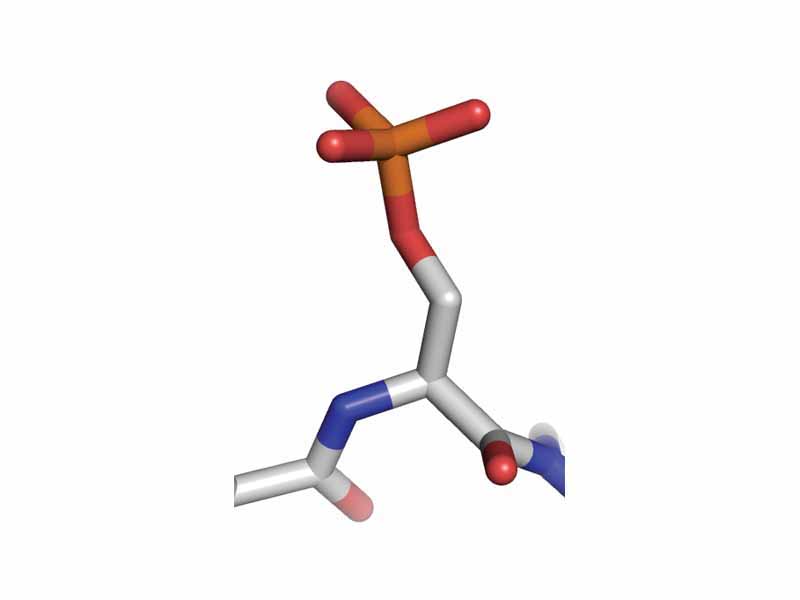Interdisciplinary Note (1 of 15)

Many enzymes, signal proteins, or other protein forms are synthesized as inactive precursors, called zymogens, to be subsequently activated by proteolytic cleavage or one or more peptide bonds. Examples include proteolytic digestive enzymes, the cascade of proteolytic activation in blood clotting, the caspase cascade in apoptosis, and the activation of many protein hormones.
Proteolytic cleavage, in other words, is a way that a protein can be activated. It's a good exercise to step back and think about other ways you know a protein may be activated. This is a crucial theme for the exam. What are some other ways that you know a protein may be converted from its inactive to active form? Unlike proteolytic cleavage, many of these ways are reversible. There are a lot of ways! Here are a few others:
Phosphorylation A kinase catalyzes the transfer of a phosphate group from ATP to a specific substrate. Examples of enzymes activated through phosphorylation by a kinase are are so numerous that even the prominent examples are too numerous too mention. For example, under glucagon signaling within a hepatocyte, cAMP-dependent protein kinase (protein kinase A, PKA) phosphorylates and activates phosphorylase kinase and fructose 2,6-bisphosphatase. Phosphorylation by a kinase might inactivate an enzyme. Under glucagon signaling, for example, while it is phosphorylating and activating the phosphorylase kinase and fructose 2,6-bisphosphatase, PKA is also phosposphorylating and inactivating pyruvate kinase, phosphofructokinase-2 and glycogen synthase. For enzymes inactivated by a kinase, activation would be carried out by a phosphatase, which removes the phosphate and releases it to the surroundings.
Allosteric interactions For many proteins, control of enzyme activity can be modeled as an quilibrium between an open conformation (relaxed, R state), to which substrate binds easily, and a closed conformation (tense, T state), which does not have high affinity for substrate. The open conformation can be stabilized by binding of an allosteric promoter while the tense form is facilitated through binding of an allosteric inhibitor. With cooperativity involving multi-subunit enzymes, the binding of the first substrate in one subunit acts to stabilize the R state of the enzyme.
Binding with another protein Some proteins are activated when another protein binds to them, or comes unbound from them. There are specialized proteins whose job it is to activate (or deactivate) a whole set of enzymes, channels, or other proteins through binding. Calmodulin is a prominent example. Once bound to Ca2+, calmodulin is activated to seek out and bind to a host of targets. In the Ca2+-saturated state, it adopts a disordered conformation. Calmodulin's ability to recognize a tremendous range of target proteins is due in large part to its structural flexibility. Moreover, the predominantly hydrophobic nature of binding between calmodulin and most of its targets allows for recognition of a broad range of target protein sequences. Calmodulin!
G proteins Everybody goes into the MCAT at least somewhat familiar with G protein-coupled receptors (GPCR). The α-subunit associated with GPCR is a G protein. This represents such a prominent context - GPCR actually takes its name from G protein activity - that there is tendency to think that G protein specifically signifies GPCR, but be prepared to run into G protein activity in many other contexts! This is a real figure of merit. G protein activity is another way that proteins have evolved to turn off and on. Ras is a G protein. Ras is the lynch-pin in growth factor receptor signaling. Growth factor receptors don't work like GPCR, but rather through intrinsic receptor tyrosine kinase activity. Ras is one of the most important proto-oncogenes (notice that when we switched from talking about the protein to the gene, we switched to italics). Growth factor signaling is not GPCR, so why is there a G protein involved? Because G protein activity is all over the place. Eukaryotic initiation factor 2 (eiF2) is a G protein (a regulatory control point in translation). The way a G protein works is that when it's not activated, it's carrying around a GDP (guanosine diphosphate). Activation occurs when it undergoes an exchange of the GDP for a GTP. GDP leaves and GTP comes onboard. When it has the GDP, the protein is "off". Having the GTP, though, it is "on". When the GTP hydrolyzes back to GDP (GTPase activity), it's turned back off. GDP with GTP exchange to turn it on. GTP to GDP hydrolysis to turn it off. It's a molecular switch.
Keep your eye out for ways proteins turn on and off. This is a major theme.
